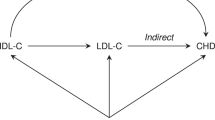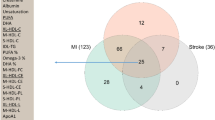Abstract
Background
Cardiovascular (CV) complications are the most significant cause of mortality in adults with Cushing disease (CD); little is known about CV risk factors in children with CD. Measurement of lipoprotein particles by nuclear magnetic resonance (NMR) spectroscopy is a novel technology to assess CV risk. The objective of the current study is to analyze the NMR lipid profile in pediatric CD patients before and 1 year after remission.
Methods
NMR lipid profile was obtained via the Vantera NMR analyzer, using frozen serum samples from 33 CD patients (mean age 13.8 ± 4.0 years) evaluated between 1997 and 2017 at the National Institutes of Health (NIH) Clinical Center (CC).
Results
GlycA (glycosylated acute-phase proteins), triglyceride-rich particles (TRLP medium and very small sizes), low-density lipoprotein (LDL) particles (LDLP total and large size), high-density lipoprotein (HDL) particles (HDLP total, medium and small sizes), total cholesterol, LDL-cholesterol, HDL-cholesterol, GlycA inflammatory biomarker, and apolipoprotein B and apolipoprotein A1 (ApoA1) concentrations showed statistically significant changes after remission of CD (p < 0.05).
Conclusion
In our study population, most of the lipid variables improved post-CD remission, with the exception of HDL and ApoA1, indicating that NMR lipoprotein profile may be a helpful tool in assessing the CV risk in pediatric patients with CD.
Similar content being viewed by others
Log in or create a free account to read this content
Gain free access to this article, as well as selected content from this journal and more on nature.com
or
References
Gkourogianni, A. et al. Pediatric Cushing disease: disparities in disease severity and outcomes in the Hispanic and African-American populations. Pediatr. Res. 82, 272–277 (2017).
Stratakis, C. A. Cushing syndrome in pediatrics. Endocrinol. Metab. Clin. N. Am. 41, 793–803 (2012).
Holst, J. M. et al. Cushing’s syndrome in children and adolescents: a Danish nationwide population-based cohort study. Eur. J. Endocrinol. 176, 567–574 (2017).
Dekkers, O. M. et al. Multisystem morbidity and mortality in Cushing’s syndrome: a cohort study. J. Clin. Endocrinol. Metab. 98, 2277–2284 (2013).
Etxabe, J. & Vazquez, J. A. Morbidity and mortality in Cushing’s disease: an epidemiological approach. Clin. Endocrinol. (Oxf.) 40, 479–484 (1994).
Lupoli, R. et al. Markers of atherosclerosis in patients with Cushing’s syndrome: a meta-analysis of literature studies. Ann. Med. 49, 206–216 (2017).
Faggiano, A. et al. Cardiovascular risk factors and common carotid artery caliber and stiffness in patients with Cushing’s disease during active disease and 1 year after disease remission. J. Clin. Endocrinol. Metab. 88, 2527–2533 (2003).
Lodish, M. B. et al. Blood pressure in pediatric patients with Cushing syndrome. J. Clin. Endocrinol. Metab. 94, 2002–2008 (2009).
Libuit, L. G. et al. A gender-dependent analysis of Cushing’s disease in childhood: pre- and postoperative follow-up. Clin. Endocrinol. (Oxf.) 83, 72–77 (2015).
Matyus, S. P. et al. NMR measurement of LDL particle number using the Vantera® Clinical Analyzer. Clin. Biochem. 47, 203–210 (2014).
Jeyarajah, E. J., Cromwell, W. C. & Otvos, J. D. Lipoprotein particle analysis by nuclear magnetic resonance spectroscopy. Clin. Lab Med. 26, 847–870 (2006).
Mora, S. Advanced lipoprotein testing and subfractionation are not (yet) ready for routine clinical use. Circulation 119, 2396–2404 (2009).
Mackey, R. H. et al. Lipoprotein particles and incident type 2 diabetes in the multi-ethnic study of atherosclerosis. Diabetes Care 38, 628–636 (2015).
Garvey, W. T. et al. Effects of insulin resistance and type 2 diabetes on lipoprotein subclass particle size and concentration determined by nuclear magnetic resonance. Diabetes 52, 453–462 (2003).
Wang, J. et al. Lipoprotein subclass profiles in individuals with varying degrees of glucose tolerance: a population-based study of 9399 Finnish men. J. Intern. Med. 272, 562–572 (2012).
Urbina, E. M. et al. Lipoprotein particle number and size predict vascular structure and function better than traditional lipids in adolescents and young adults. J. Clin. Lipidol. 11, 1023–1031 (2017).
Shah, A. S. et al. Superiority of lipoprotein particle number to detect associations with arterial thickness and stiffness in obese youth with and without prediabetes. J. Clin. Lipidol. 10, 610–618 (2016).
McGarrah, R. W. et al. A novel protein glycan-derived inflammation biomarker independently predicts cardiovascular disease and modifies the association of HDL subclasses with mortality. Clin. Chem. 63, 288–296 (2017).
Jago, R. et al. Novel measures of inflammation and insulin resistance are related to obesity and fitness in a diverse sample of 11–14 year olds: The HEALTHY Study. Int. J. Obes. (Lond.) 40, 1157–1163 (2016).
Feingold, K., Brinton, E. A. & Grunfeld, C. in The Effect of Endocrine Disorders on Lipids and Lipoproteins Endotext [Internet] (eds De Groot, L. J. et al.) (MDText.com Inc., South Dartmouth, 2017).
Arnaldi, G. et al. Pathophysiology of dyslipidemia in Cushing’s syndrome. Neuroendocrinology 92, 86–90 (2010).
Mancini, T., Kola, B., Mantero, F., Boscaro, M. & Arnaldi, G. High cardiovascular risk in patients with Cushing’s syndrome according to 1999WHO/ISH guidelines. Clin. Endocrinol. (Oxf.) 61, 768–777 (2004).
Acknowledgements
This research was supported by the Intramural Research Program of the Eunice Kennedy Shriver NICHD, NIH.
Author information
Authors and Affiliations
Contributions
Substantial contributions to conception and design, acquisition of data, or analysis and interpretation of data: A.M., A.C., N.S., A.T.R., M.S., M.K., E.B., C.L., M.D.L.L.S., C.A.S., M.L. Drafting the article or revising it critically for important intellectual content: A.M., N.S., C.A.S., M.Ldish. Final approval of the version to be published: A.T.R., C.A.S., M.L.
Corresponding author
Ethics declarations
Competing interests
The authors declare no competing interests.
Additional information
Publisher’s note: Springer Nature remains neutral with regard to jurisdictional claims in published maps and institutional affiliations.
Rights and permissions
About this article
Cite this article
Makri, A., Cheung, A., Sinaii, N. et al. Lipoprotein particles in patients with pediatric Cushing disease and possible cardiovascular risks. Pediatr Res 86, 375–381 (2019). https://doi.org/10.1038/s41390-019-0438-0
Received:
Revised:
Accepted:
Published:
Issue date:
DOI: https://doi.org/10.1038/s41390-019-0438-0
This article is cited by
-
Childhood Obesity and Cardiovascular Disease Risk
Current Atherosclerosis Reports (2023)
-
Differential Effects of Amount, Intensity, and Mode of Exercise Training on Insulin Sensitivity and Glucose Homeostasis: A Narrative Review
Sports Medicine - Open (2022)



